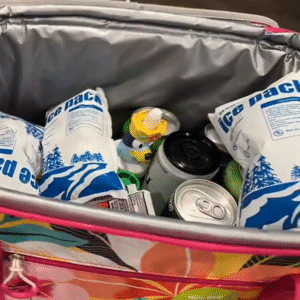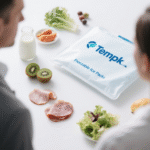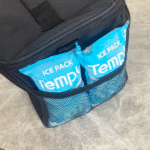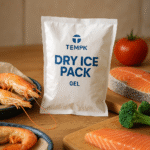Pacotes de gelo seco refrigerante: 2025 Guia do comprador
Refrigerant dry ice packs keep products ultra‑cold for long routes while controlling cost and risk. If you need −70 °C performance for 24–120 hours, these packs can outperform gel or PCM systems—when you size, ventilação, and label them correctly. Below you’ll find a practical sizing method, current 2025 regras, and side‑by‑side trade‑offs so you can choose confidently and ship with fewer temperature excursions.
-
Where refrigerant dry ice packs truly excel for ultra‑cold lanes and what “−78.5 °C” means in the real world. USGS
-
How to size refrigerant dry ice packs using a quick calculator and realistic sublimation rates. Sonoco ThermoSafe+1
-
2025 Essentials de conformidade (UN1845, FAA/TSA 2.5 kg, USPS 5 lb, Atualizações da IATA), plus labeling and venting. Administração Federal de Aviação+2Postal Explorer+2
-
Gelo seco vs.. gel/PCM packs—when to switch, hybrid builds, and cost/weight impacts.
-
Básico de segurança (PEL/REL, Idlh, ventilação) to protect teams and facilities. CDC+1
-
2025 sustainability pressures (EU PPWR timelines) and what they mean for reusable shippers. Ambiente+1
What are refrigerant dry ice packs, and when should you use them?
Resposta curta: Refrigerant dry ice packs are insulated parcel systems that use solid CO₂ (gelo seco) as the cooling medium to hold product near −70 °C for long durations. Use them for biologics, specialty foods, and lab samples requiring deep‑frozen conditions. Gelo seco sublimados (turns to gas) at about −78.5 °C, so it never melts into water and won’t soak cartons. USGS
Why that matters: You get stable, ultra‑cold performance without condensate—ideal for vaccines, enzymes, and high‑fat frozen foods. Because dry ice gives off CO₂ gas as it sublimates, your shipper must ventilação and be devidamente rotulado por 2025 regras. Passenger‑carried amounts are capped; carrier shipments require UN1845 and net weight marks. We’ll cover the exact limits and labels below so your packs pass acceptance on the first try. Administração Federal de Aviação+1
What temperature do refrigerant dry ice packs actually hold?
Detalhe: Dry ice transitions directly from solid to gas at -78,5 ° C. (−109,3°F). Na prática, product temperature depends on payload mass, isolamento (EPS, Pur, VIP), packout geometry, e frequência de abertura. Laboratory work and industry guidance show typical sublimation rates ranging from ~3–8% per day in well‑insulated systems, but rates climb sharply with thin walls or frequent access. Expect faster loss with pellets vs. blocos. Sonoco ThermoSafe+1
| Fator | Faixa Típica | Effect on Hold Time | O que isso significa para você |
|---|---|---|---|
| Insulation type | EPS 1–1.5″, PUR 1–2″, VIP 0.3–0.5″ | Higher R‑value = longer duration | Upgrade to PUR/VIP to cut dry ice mass and freight |
| Dry ice form | Blocks vs.. Pellets | Blocks sublimate slower | Use blocks for >48 h lanes; pellets for tight spaces |
| Proporção de preenchimento | 70–90% internal volume | Less air = slower sublimation | Right‑size the shipper; avoid oversized voids |
| Access frequency | 0–3 openings/day | Each opening spikes load | For last‑mile, add a “do not open” panel |
Dicas e sugestões práticas
-
For weekly biologics lanes: Precondition shipper to ≤ −20 °C, use blocks in lower layer, pelotas para preencher vazios, and add a vent path.
-
For export seafood: Use VIP liners to control weight, and stage a top‑off port to replenish at hub handoffs.
-
For field kits: Pre‑bag dry ice; include a “vent check” sticker and a CO₂ exposure card for staff.
Caso do mundo real: A gene‑therapy lab cut excursions by 42% after switching to blocks‑plus‑pellets and adding a one‑way vent disk. The same lane maintained −65 °C or colder for 72 horas com 15% less dry ice than the previous design.
How much dry ice do refrigerant dry ice packs need?
Resposta curta: Start with a simple rule of thumb: 5–10lb (2.3–4,5 kg) of dry ice per 24 hours in a standard, expedidor bem isolado. For higher‑R designs (VIP), you can target the low end; for thin EPS or hot climates, plan the high end. Laboratory and field data show ~2%/hour in small parcels during flight profiles, so build a safety margin. WestAir+1
Orientação expandida: Your dry‑ice load must cover (1) heat gain through the walls, (2) product warm‑up, e (3) handling events. You’ll get better accuracy by combining a baseline daily rate com um time factor e a climate factor. For bio‑payloads that are already deep‑frozen, you only fight ambient heat; for warm payload starts, add extra for pull‑down. Use blocks where possible; they last longer than pellets at the same mass. dryiceproduction.com
Quick sizing calculator (use before each lane launch)
Exemplo: 60‑hour route, Remetente VIP (R=6), hot season (C=1.2), first run (S=1.25):
Dry_Ice_lb ≈ (60/24) × 6 × 1.2 × 1.25 = 22.5 Libra (round to 24 lb).
Dica: Validate against typical field rates (5–10lb/dia). If you’re outside that band, re‑check insulation and packout.
Are refrigerant dry ice packs safe and compliant in 2025?
Resposta curta: Yes—when you ventilação, rótulo, and stay within limits. For airline passengers, O limite é 2.5 kg (5.5 Libra) por pessoa, with airline approval and non‑airtight packaging. For USPS domestic air, a mailpiece may contain ≤5lb de gelo seco. Commercial shipments must follow IATA DGR: marca UN1845, Nome de envio adequado, Peso líquido, e aplique um Aula 9 rótulo; operators may impose aircraft‑type limits. Administração Federal de Aviação+2Postal Explorer+2
What to do today: Use a vented outer, insulated inner, and print the UN number and NET KG on the box side. Acceptance teams increasingly use checklists; o 2026 IATA dry‑ice acceptance form mirrors what many carriers already request. Em caso de dúvida, attach the checklist to your airway bill and include the net dry‑ice weight on documentation. IATA
Safety limits and staff protection (simples, practical)
Exposição co₂: OSHA’s 8‑hour limit and NIOSH’s recommended exposure limit for CO₂ are 5,000 ppm; NIOSH’s IDLH is 40,000 ppm. Train staff to open shippers in ventilated areas, never seal dry ice in airtight containers, and avoid walk‑ins with poor airflow. Osha+1
| Tópico | 2025 Regra geral | What to Mark | Por que isso importa para você |
|---|---|---|---|
| Passenger allowance | ≤2,5 kg (5.5 Libra) por passageiro | “Gelo seco” + Peso líquido (ou “≤2,5 kg”) | Avoid confiscation at check‑in. Administração Federal de Aviação |
| Ar doméstico USPS | ≤5 lb por correspondência | UN1845 + venting instruction | Fast acceptance; avoid returns. Postal Explorer |
| IATA cargo | UN1845 + Aula 9 + NET KG | Printed on outer box | Required worldwide; operator limits may apply. IATA |
| Ventilação | Nunca hermeticamente; provide a gas path | Vent ports or loose‑fit lid | Prevent pressure build‑up and damage. Pace University |
Dicas e sugestões práticas
-
Warehouse SOP: Place opening tables near exhaust or open dock doors; post a 5‑step “vent‑check” placard.
-
Traveler SOP: Pre‑print a simple “DRY ICE / 2.5 kg or less” card for baggage.
-
Cargo SOP: Add “Net dry ice: X kg” on two adjacent sides; attach operator checklist to the pouch.
Caso real: A biotech reduced carrier rejections to near zero after adding UN1845 marks and net‑kg print to two panels, plus a perforated vent hole with a tamper label. Post‑change, five consecutive lanes cleared acceptance without rework.
How do refrigerant dry ice packs compare to gel and PCM packs?
Resposta curta: Refrigerant dry ice packs lead for below −20 °C setpoints, long holds, and small interiors. Pacotes de gel/PCM win for 2–8 ° C. ou -20 ° C. pistas, returns programs, and carrier rules that disfavor dry ice. Pacotes híbridos (dry ice base + PCM buffer near product) can stabilize curves and reduce weight.
Expanded view: Think of dry ice as a “deep‑freeze engine.” It’s powerful but needs venting and labeling. PCMs are “thermostats” at precise setpoints (por exemplo, −21, +5 ° c) and are easier to reuse. For last‑mile, PCMs simplify hand‑offs; for international lanes or biotech, dry ice often remains the smallest, lightest path to 72–120 hours.
When to choose what (decision guide)
-
Pick refrigerant dry ice packs quando: Ultra -frio, small payloads, long flights, and strict stability curves.
-
Pick PCM/gel quando: setpoint is −20 °C or 2–8 °C, reverse logistics matter, or staff training is minimal.
-
Pick hybrid quando: you need −60 °C near the ice layer but protect the product with −20 °C PCM spacers.
Designing refrigerant dry ice packs: isolamento, ventilação, rótulos
Resposta curta: Durável PUR ou VIP walls cut dry‑ice mass and freight; blocos extend hold time; vented lids prevent pressure issues; UN1845 + Aula 9 + NET KG labeling accelerates acceptance. A little design for assembly (DFA)—pre‑bagging ice, printed panels—reduces packout mistakes.
Mergulho profundo: Thermal design is about minimizing heat leak (U·A·ΔT). VIP panels slash A and U without adding bulk. Blocks lower surface area vs. Pellets, reducing sublimation. Operationally, locate venting away from the payload and provide a one‑way check if the box might be stacked tightly.
UN1845, Aula 9, and airline limits (2025 snapshot)
-
Passageiros: ≤ 2.5 kg per person; aprovação da companhia aérea; non‑airtight embalagem; mark “Dry ice” and net quantity or “≤ 2.5 kg.” Administração Federal de Aviação
-
Ar doméstico USPS: ≤5 lb por correspondência; embalagem deve allow gas release. Postal Explorer
-
IATA cargo: Marca UN1845, Nome adequado, net kg on outer, e aplicar Aula 9 rótulo; aircraft‑type limits apply per 2025 DGR updates/addenda. IATA
Insulation options at a glance
| Isolamento | Typical Wall | Relative R | For refrigerant dry ice packs this means… |
|---|---|---|---|
| EPS | 1.0–1.5 in | Baixo | Works for short lanes; more ice needed; lowest cost |
| Pur | 1.5–2.0 in | Médio | Good balance of cost vs. peso; fewer top‑offs |
| VIP | 0.3–0.5 in | Alto | Longest hold in smallest box; great for air freight |
Operations playbooks for refrigerant dry ice packs
Resposta direta: Standardize on one packout per lane, pre‑print UN1845 painéis, and implement a two‑point weight check (before/after) to verify net kg. For biologics, stage a hybrid buffer around the payload and avoid opening during transit.
Explicação expandida: The biggest excursion risks are at hand‑offs. Use a “Don’t Open” strip across the lid and a QR card to SOPs. At hubs, top‑off stations can add 10–20% mass in under a minute. Para comida, pre‑freeze to −20 °C or colder and prevent voids with pellets.
Comida, Biologics, and lab kits—specific moves
-
Comida: Freeze payload solid; usar blocks under, pellets around; reinforce corners; post “vent here.”
-
Biologics: Hybrid buffer with PCM around the carton; document NET KG e shipper ID no rótulo.
-
Lab kits: Pre‑bag dry ice; adicionar Co₂ segurança insert; provide luvas e face shield in a consumables kit.
Caso real: A seafood exporter adopted VIP liners and blocks, cutting dry‑ice mass by ~28% while holding −60 °C for 72 h in midsummer across two hubs. Damaged‑label returns fell after adding side‑panel net‑kg prints.
Troubleshooting refrigerant dry ice packs in transit
Resposta direta: If hold time is short, check insulation gaps, pellet‑only loading, and airtight lids primeiro. If labels fail acceptance, confirm UN1845, Aula 9, e NET KG are printed and visible.
Deeper fixes: Map excursions to events: “openings,” “hub time,” or “final‑mile delays.” Add registradores de dados e shock/light indicators. If the route is volatile, redesign with VIP ou hybrid buffers and raise the safety factor in your sizing formula to 1.25–1.35.
Field checklist (use at the bench)
-
Vent path clear?
-
Net kg printed on side panel?
-
Blocks on bottom, pellets filling voids?
-
QC weighed? Signed?
-
Logger started? Sticker applied?
2025 trends for refrigerant dry ice packs
Visão geral da tendência: Three forces shape 2025 decisões: (1) regulatory clarity around dry‑ice marking and airline limits in the latest IATA DGR addendum, (2) greater safety emphasis on CO₂ exposure (PEL/REL and IDLH training), e (3) packaging‑waste pressure in the EU’s PPWR, which entered into force on 11 February 2025 and phases in reuse/recyclability obligations over the next 18 meses. Expect more reusable shells with replaceable VIP liners. IATA+2Osha+2
What’s new and why it matters
-
Listas de verificação de aceitação da IATA: Standardized forms streamline hand‑offs; attach them to your pouch. IATA
-
CO₂ safety refreshers: Teams double‑check ventilation and PPE due to clear PEL/REL/IDLH guidance. Osha+1
-
EU PPWR reality: Reuse and recyclability targets push VIP‑based reusables and lighter outers. Ambiente+1
Insight de mercado: Airlines and integrators continue to cap per‑piece dry ice for certain aircraft; labeling and net‑kg prints speed acceptance. Enquanto isso, COVID‑era ultra‑cold lanes have normalized: many current vaccines now arrive frozen and may be refrigerated for extended periods after receipt, reducing dry‑ice dwell at the last mile. Ainda, long‑haul biologics rely on dry ice for comfort margin. Pfizer Medical
Perguntas frequentes
Q1: What temperature do refrigerant dry ice packs hold?
They stabilize near -78,5 ° C. at the ice interface. Product temperature varies with insulation and geometry, but dry ice won’t create liquid water like frozen gel does. USGS
Q2: How much can I carry on a plane?
Para passageiros, ≤2,5 kg (5.5 Libra) por pessoa com aprovação da companhia aérea; packaging must be ventilado and marked “Dry ice.” Administração Federal de Aviação
Q3: What about USPS?
USPS allows ≤5lb of dry ice per domestic air mailpiece; packages must permit gas release and be properly marked. Postal Explorer
Q4: What’s a realistic sublimation rate?
Plan around 5–10lb por 24h in a good insulated cooler; small flight parcels often show ~2%/hour. Use blocks to slow loss. WestAir+1
Q5: É seguro de gelo seco para manusear?
Sim, with gloves and ventilation. OSHA/NIOSH place time‑weighted limits at 5,000 ppm and an IDLH at 40,000 ppm para co₂. Osha+1
Resumo e recomendações
Takeaways -chave: Refrigerant dry ice packs are the best choice for ultra‑cold, long‑duration lanes. Size them with a simple (time × daily rate × climate × safety) method, and choose blocos whenever possible. Em 2025, you must ventilação, Mark UN1845 + NET KG + Aula 9, and respect 2.5 kg passenger e 5 lb USPS limiares. Train for CO₂ safety; temperaturas de log; standardize packouts.
Plano de ação:
-
Selecione isolamento (PUR/VIP) for your lane and run the quick calculator.
-
Lock a single SOP per lane; imprimir UN1845 panels with NET KG.
-
Pilot 5–10 shipments with data loggers; ajustar R, C, S factors.
-
For EU routes, start reusable trials to prepare for PPWR obligations.
-
Roll out training on CO₂ exposure and acceptance checklists.
Sobre Tempk
We engineer cold‑chain packaging that is simple to pack, easy to approve, and hard to fail. Nosso refrigerant dry ice packs e VIP hybrid systems balance weight and hold time, with printed UN1845/net‑kg panels for faster acceptance. Customers typically cut dry‑ice mass by 15–30% while keeping the same or better duration. We pair designs with lane‑specific calculators and SOP cards so your team can pack right on day one.
Próximo passo: Contact our team for a lane assessment and a right‑sized refrigerant dry ice pack prototype for your route.
























